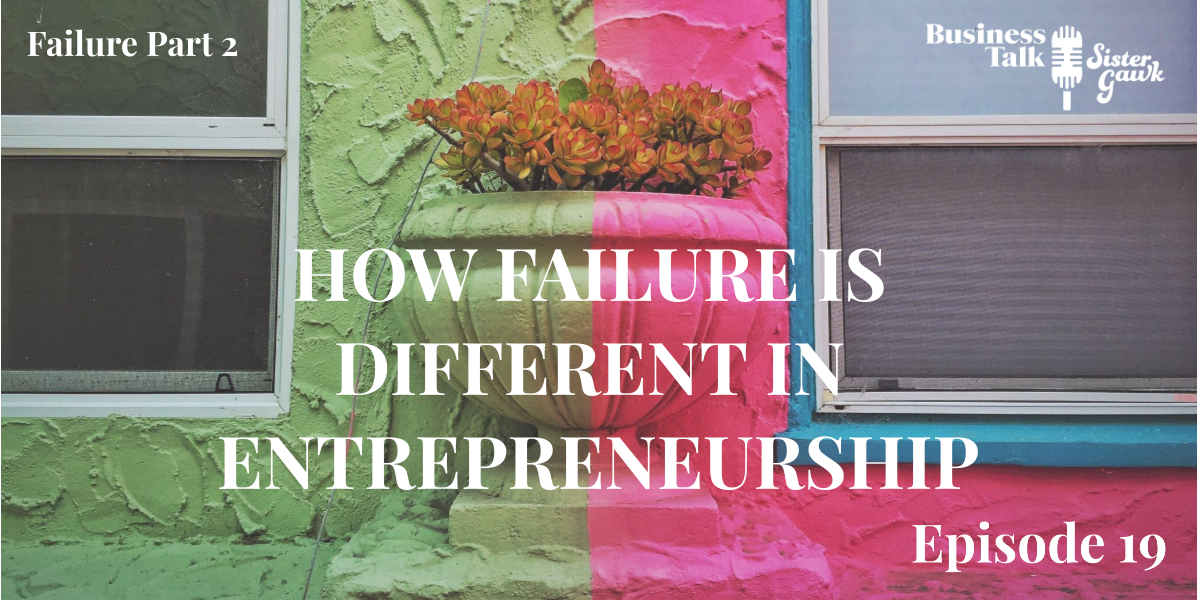This episode digs into the phases of a business launch and how it affects the founder of the business. We talk through the turning point where many businesses fail, some of the reasons that they struggle to succeed, and how confidence relates to skill level within Paul Hersey’s Situational Leadership Model.
Understand the Cycles of Failure for Entrepreneurs
Bekkah: Today we are continuing with episode 2 of our three-part series on the topic of failure. This episode is
specifically going to be covering what entrepreneurship failure looks like. Specifically what it looks like to fail in entrepreneurship and how to get back up and keep going. In the past, I’ve been doing some studying on this theory of research by Paul Hersey called Situational Leadership. He’s done a ton of things looking at the different stages of skill and confidence level of people when they come into new situations and what it looks like to lead through that. I love this theory because it’s so interesting to see different graph points of confidence versus skill and how these things interact with one another. We’re going to talk about it and get really nerdy. How is entrepreneurship different in this way and how we need to see what happens in entrepreneurship in these phases that he discusses? Ruthie, do you want to give us a little description of what this confidence interval or situational leadership graph looks like?
Ruthie: It kind of looks like an upside-down bell curve. It goes up and then it goes down in the loop and then it goes back up again. That’s kind of what the graph looks like but breaking down each phase of that graph – there are four different stages. Let’s put this in the framework of entrepreneurship. Say you’re working on something like when we interviewed Thea Dudley. She basically talked about how she was doing something really well for a long time and then decided to launch into her own business and do it on her own. Say you’re doing tech development for a different company and then you decide to do tech development on your own. You’ve been doing it really, really well for this company and then you think, “Okay! Here we go I’m going to start my own business!” You get thrown into this whole new framework of basically lack of structure in your own new business. Stage one is when you’re on that high. You think, “Yeah! I can do this!” It’s so exciting and it’s new. Then things kind of start to decline from there for a bit. Bekkah is going to talk with us about that.
Bekkah: When we’re talking about our X and y-axis, our Y access in looking at this upside-down bell curve is confidence. You start with super high confidence, but then our x-axis is skill. You might have low skill when you first start entrepreneurship but you have really high confidence because otherwise, you wouldn’t be starting a business.
That’s where we start. High confidence low skill. That’s stage one Paul Hersey calls this stage the Honeymoon Phase. Everything is perfect everything is rosy we’re going to figure it out. Phase two is the “Trough of Despair” as it’s called. That’s where your confidence tanks. It goes way down! We’re now scraping the bottom of the upside-down bell curve. That’s where you’re improving your skill but you have no confidence. A lot of entrepreneurs go through this. They start out really strong they’re really excited and then people start rejecting them or saying, “No, your product really isn’t what I need. Thanks so much but, no.” People start saying no and all of a sudden you feel like maybe you was wrong or you messed up completely.
Or maybe it’s that another product enters the market that’s similar to yours or a service. You start to think, “I’m not unique enough” or “How can I differentiate myself? I am just a failure because they’re doing so much better than I am.” But maybe they are not you just think they are. There’s this whole thought process wrestling with “I don’t know if I can keep going.” A lot of people hit the trough of despair also because of cash flow. This is actually more common than you would think! Ruthie, what statistic did you say before? People under 30 are more likely to fail in business when they start their own
business?
Know the Numbers and Do Your Research
Ruthie: Business owners under the age of 30 are more likely to fail.
Bekkah: That’s scary, right? Think about that! If you think like, “I’m going to get so much money so fast.” If you’re not budgeting mentally for that I can totally see if you bottom out financially right here and you don’t have any more money to invest, you would stay in the Trough of Despair and quit. Maybe you thought, “I can put aside six months of savings to get myself through and then start my business.” All of a sudden you realize, “Whoa! I need to pay rent and this is not paying for itself!” I can see why a lot of people are done right there.
Ruthie: 29 percent of small businesses fail because they run out of cash. That’s a good thing to keep in mind!
Bekkah: That’s almost a third! Just a little under a third run out of cash. I was just talking to my sister-in-law last weekend and she was saying, “You know, most people don’t plan in the restaurant business for three years of negative cash flow before they actually start turning a profit.” I thought that that was a long time to not make money! Do you have what it takes to last financially for three years? Know the industry as we talked about in the last episode. Get some data, understand what a sample size is. Is it biased? Take a poll. See if your services are needed. All of that is important so that you have good confidence going into stage one.
Then in stage two, you need to work through the Trough of Despair because if you don’t, that’s when you fail as a business. A lot of times this is the point when people hit the bottom they’re done. They give up. They think, “I tried this! Business apparently isn’t for me. I’m done with this.” The next phase, if you get past that with the mentality of, “I have enough cash flow to keep me going. I’m just going to keep trying it and see if I can get through this.” Or maybe it’s the confidence thing. The third phase is the Confidence Climb. This is where you are still moving forward on the x-axis towards high skill. You’re not there yet but you’re getting there. In entrepreneurship, maybe you’re really good at what you do in your own job that you previously did, but you still need more support. Maybe you need to be better about keeping or whatever. You’re still moving up and moving up. It’s climbing in confidence. There’s an aspect of this phase that can be where you start experiencing impostor syndrome. Ruthie had a definition for this.
Impostor Syndrome and Why You Deserve the Success You’ve Achieved
Ruthie: Courtesy of Wikipedia – “Impostor syndrome is a psychological pattern in which one doubts one’s accomplishments and has a persistent internalized fear of being exposed as a fraud.” This is basically when you get better and better at something but you’re constantly having this underlying feeling of “I don’t deserve the success I’m having.” As you start to climb towards success in business keep in mind that success, in this case, is often just getting better at whatever it is that you are doing.
Money is not the only gauge of success when it comes to business. As you get more skilled and they get more clients or whatever else there’s this constant sense of, “I don’t deserve this. I got this all because of luck. This is not because of my own merit. That’s something you have to combat all the time because you’ve worked your butt off to get there! You do deserve all the things that you’ve been working towards because you put in the hours and you’ve done the really good marketing and you’ve done all of that research. That’s definitely something to be aware of in this stage 3.
Bekkah: I think this stage actually can be different for every single person when experiencing impostor syndrome. The reason I think that is because some people think, “Wow I’m making so much money! I must be doing something right but I don’t feel like I deserve it.” But then there are other people that are like, “These people are paying me too much money! I don’t think I’m worth that!” or “I don’t know if my skills or advice are actually going to work.” If I consult on something and I say, “This is what you need to do” and I’m in stage three of the confidence climb I think, “Oh, wait! Am I 100% confident that that’s exactly what they need to do? Am I an impostor? Is this going to work?”
I definitely know when I first started my business I went through that! “I know what I’m talking about but do I? Is there someone out there that’s better than me that I should be referring this person to or should they be really working with me? Am I confident that this is going to be successful? That’s a scary thing to think about! That’s why I love data! Because then you can prove that you knew what you were talking about because I can track it with accountability.
It’s really important to think about how you are going to go through this stage and confidence climb. Every time your business pivots you’re probably going to go through this entire thing all over again. In the last stage, phase four is called “Mastery”. When we talked about the bell curve – confidence high then it goes low then it goes high again – this is the very other side of the bell curve.
In this model, the bell curve isn’t completely a mirror image of itself on both sides. This actually has higher confidence than when you started, so it’s a little bit more of a higher bump when you get into mastery. This is something that some people statistically will never reach. We talked about how within the first year you’ve got a little over 20 percent of people dropping off from entrepreneurship. The five-year mark of entrepreneurship is even fewer people than that of the first year. The ten-year mark is incredibly rare. Sometimes you don’t reach the 10-year mark because you sold your company and you didn’t want to last for that long.
Rebuilding Confidence When Your Business Shifts Focus
Think about this, being at the top of stage four where you’re really understanding that, yes, you know what you’re doing. Going back to that “pivot” again, you can know what you are doing only as long as the industry and the environment around you never changes. Let’s give an example of managing people. Say I was to hire someone and promote them to a job. There is all this information out there about how you could coach someone through these stages. In the first stage, you say, “Great! You’re in this new position! Learn all this new stuff and let’s do the onboarding process.” Then stage two when the person in this new role thinks, “Man, I’m just failing I don’t really feel right about this.” You could manage that person in a different way by giving small tasks.
I read this really cool article about specifically managing people through becoming managers – managing a manager to keep them on your team. This is actually statistically a common way that p people who are in the tech industry after they get promoted when they hit this trough of despair in stage 2 they quit. They forget ever doing management again because they don’t think they’re good at it and then they leave completely. Let me reference the article so you guys can check it out too. It’s called “How the Best Managers Keep Star Talent” It’s a really good article. He talks about specifically how to manage someone through those hiring phases. If you are failing or this person is really struggling you’re supposed to give them super teeny tasks to do so that they feel successful in something to help them get out of the trough of despair.
The Importance of Mentors
As an entrepreneur, you don’t have a manager that you can go talk to every time you feel like you’re down in the dumps. In a lot of the other data that we had researched and seen statistically the people who do run successful businesses sought out mentors. Even though they don’t have a manager in a corporate job that’s saying, “Let me help you through this and walk you through what you need to do next to be successful.” They went and found those people and talked with them. Whether they’re friends or family, etc. I talked to my mom sometimes. Sometimes she’s really great and sometimes she’s not so great at helping.
Think about it! Who are those people that you bounce ideas off of, get re-energized, and get back up and going? That’s really what’s going to help you in entrepreneurship. Get out of this phase. A few months ago I talked with this lady who completely pivoted her business. She said, “Yeah, we were running for good five years and then the economy changed, things were happening, our business was not needed or necessary in terms of what was going on in society, and we had to rethink our entire business and relaunch and rebrand into something new to stay viable within the market.” To me, that’s like whoa! First of all, you need a lot of people around you to help you through that. Second of all, you’re going through every single one of these stages again. My theory is that you don’t actually just hit one trough of despair in business. You don’t. You hit like 80 toughs or despair. It’s usually like 80 troughs every year. Ruthie, can you attest to this at all in what you’ve been doing with your business?
Ruthie: Yeah, instead of just that one upside-down bell curve it’s kind of a giant squiggle. Up and down and up and down. It’s that constantly having to be your own manager, having to manage your own time, having to set your own deadlines. One thing that’s interesting in a corporate setting when you’re working for someone else, more often than not you have one task or job area and you get really good at that one task or area and you master that. Whereas with an entrepreneur you have to be good at so many different things! You’re just jack of all trades. You’re constantly learning then you have to learn a new skill and another and another. You’re going through one-two-three-four phases again and then you’re having to relearn and relearn and relearn but it’s a constant climb towards more confidence and higher skill as you keep going.
It also just depends on what’s happening and happening in your life too it’s not just strictly business. Entrepreneurship is just such a personal thing because you’re doing it. It’s your baby! So many different things in your life can really influence that. It’s also playing in those personal home factors and that trough of despair might last a little bit longer. Maybe you’ve had a death in your family. Maybe you’ve had really hard financial instability or something like that and that trough lasts a little bit longer than maybe it did last time. As you navigate that you get to see these themes better and ask yourself, “Okay, what helped me last time? Who did I go to last time that was able to help me through this specific kind of crisis?” Then you start to build that mental map and think, “Okay, I know that this is where I’m starting from and I know it’s going to get a little bit harder but I know how to bounce back from that.”
For me, sales is hard for me. It’s hard for me to sell myself. I love to sell things for other people in fundraisers. We’ve talked about that before. I love that, but when it comes to “You should work with me because this is what I do and it proves valuable” that’s something that I’m constantly learning and relearning and having to regain confidence in that. That imposter syndrome again. I know what I’m doing I’m competent in this and I’m good at it and once I’m doing it, I love it! Coming back to that again and again and again. Then moving forward from there. That constant sense of “what can I be doing right now to get myself out of this stage and what can I do to propel not only myself but my business forward?” That’s something that’s a little bit unique to entrepreneurs I think.
Discouragement Will Come, Let It and Move Foward
Bekkah: Oh my goodness. I took a picture of this, and I’m so grateful that I write on random pieces of mail sometimes because then I have the timestamps of the actual time frame I was going through these things. I don’t use post-its I’m cheap. Just kidding, but I have this picture on my phone from January 7th, 2019 so this is quite a while ago. On this list of things that I have to do, I literally, worked into my day my despair. I am such a checklist person. I need to do a checklist and say, “Yep! Did that, now I need to move on.” I know this about myself and I know I have this trough of despair. My checklist reads, “Flip laundry, grovel in despair before God, plan to check Google search console, check Craigslist, make a latte, grovel in despair again, post a blog,” I love that this is something that is that tangible in my life that I can say” Here I am again groveling in despair. It’s okay. Let’s just check it off the list and move on.”
You guys, tears are pretty common for me. I have an understanding that I am in a new place of pivoting my business, understanding it, and then moving forward. Know that this isn’t us throwing out there that we are just talking about this to make you feel good because quite honestly I hate podcasts that do that. This is scientific data researched information which is why we pulled information about situational leadership from Paul Hersey.
This is the stuff that’s happening in entrepreneurship. We don’t want you to take our word for it because we gave these cute personal stories where we laughed about things and blah blah blah. Sometimes that does touch people’s hearts, but I’m a data person and I need to know this isn’t just a one-time experience based on what we went through. No, this happens to everybody, but know that what you need to do is be self-aware about what you can do to get through it.
If you enjoyed our podcast this week, you can check out our previous episodes here!




